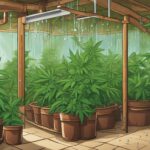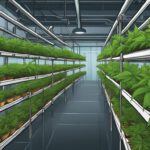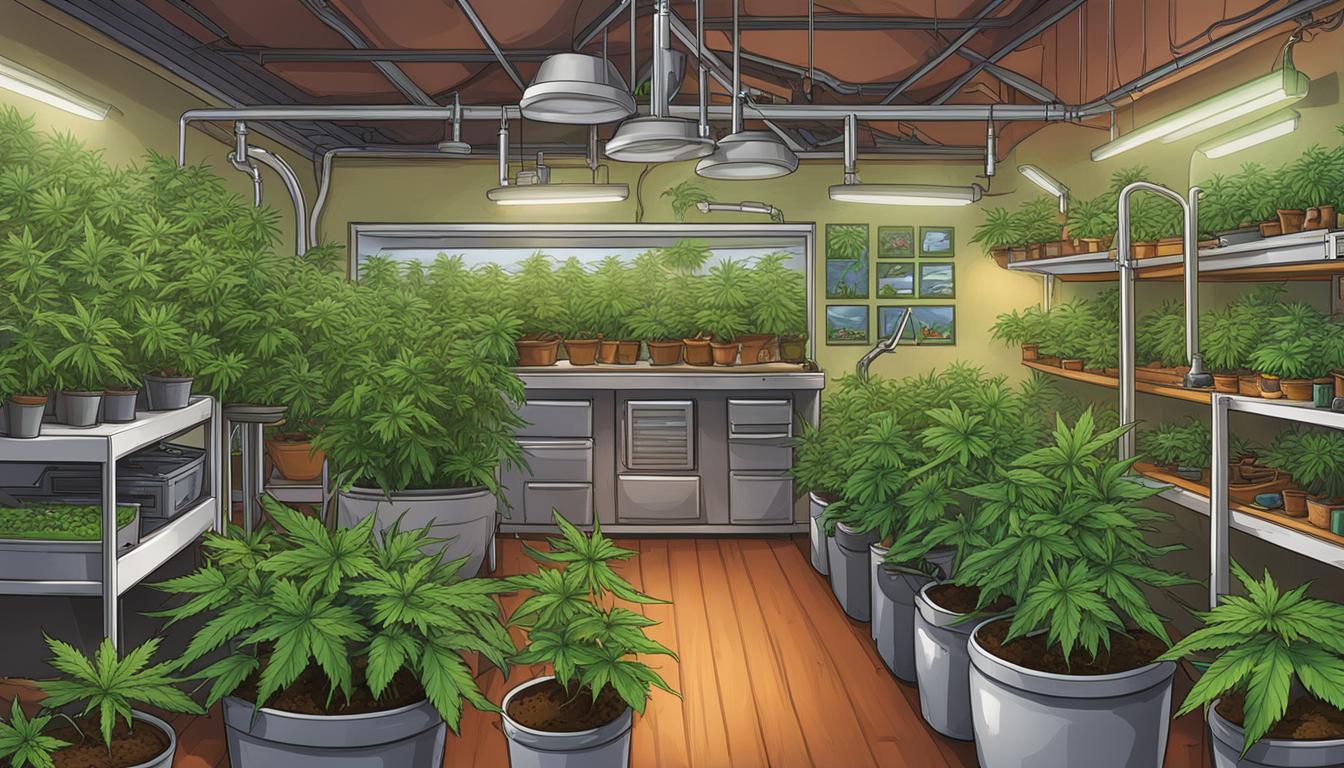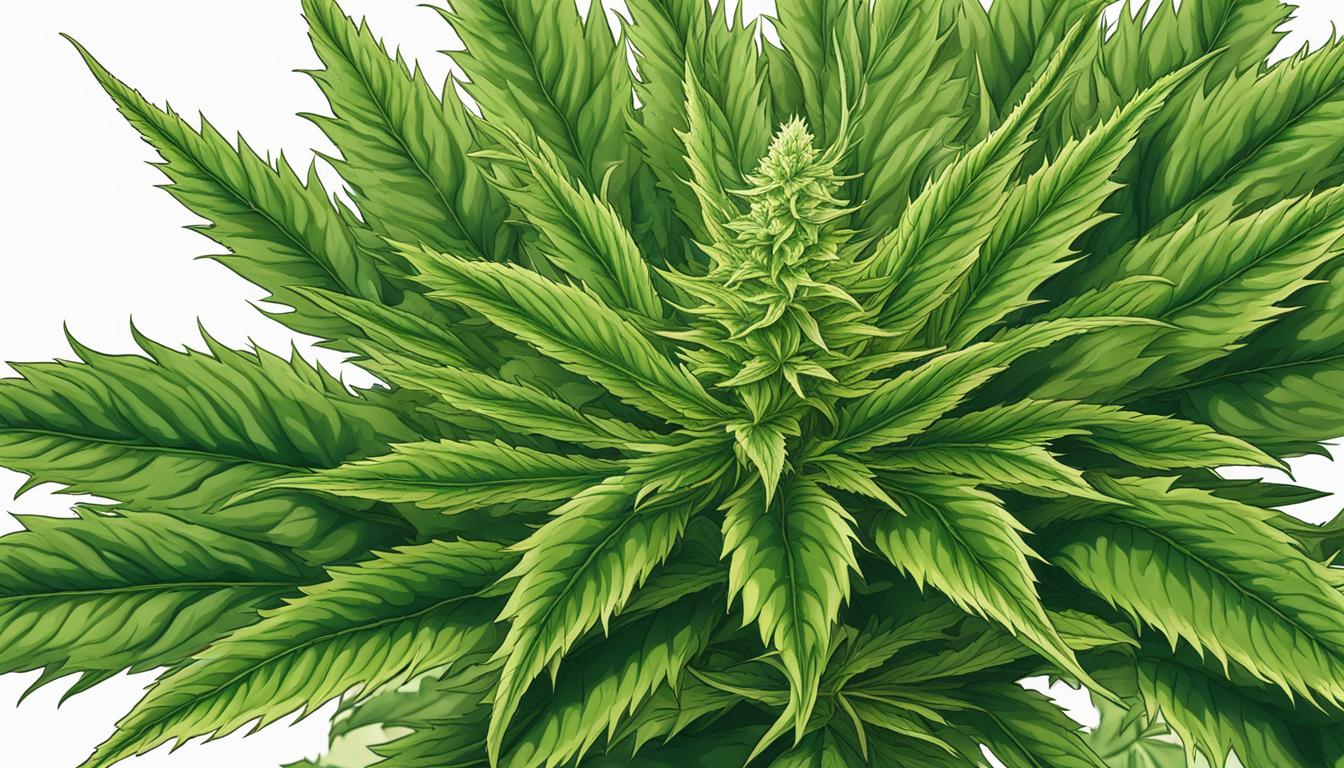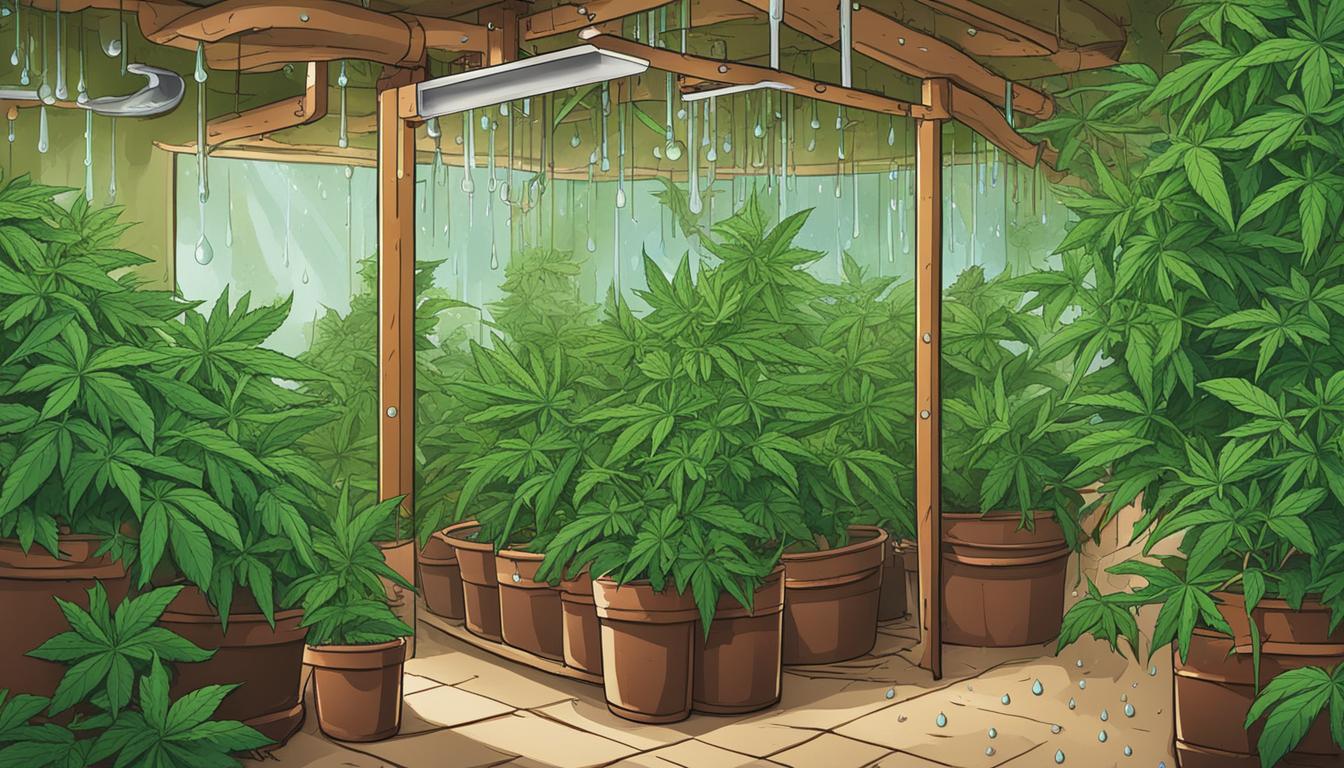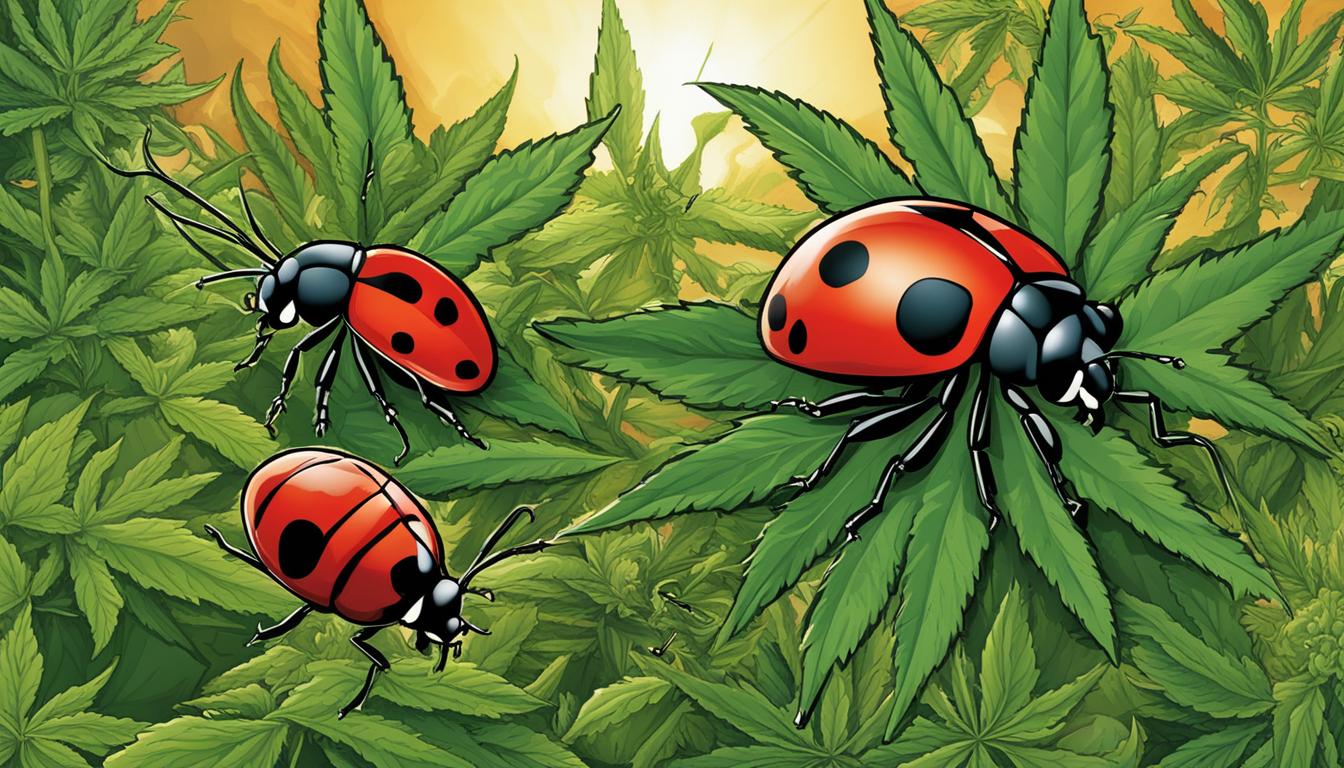Are you considering growing cannabis indoors? To ensure a successful harvest, it’s crucial to equip yourself with the essential equipment for indoor cannabis growing. From hydroponic systems to grow lights, ventilation systems, and pruning tools, each component plays a vital role in creating an optimal growing environment.
Creating a suitable environment for cannabis growth involves a lot of trial and error and can be a learning curve for new growers. However, with the right equipment and knowledge, you can maximize your yields and achieve remarkable results. In this comprehensive guide, we’ll explore the necessary tools, systems, and accessories for indoor cannabis cultivation.
Key Takeaways:
- Equipping yourself with essential equipment is crucial for successful indoor cannabis cultivation.
- Hydroponic systems provide a soilless growing method that allows for precise control over nutrient delivery.
- The right grow light intensity and spectrum are essential for healthy cannabis growth.
- Proper air circulation and odor control are crucial for indoor cannabis cultivation.
- Cannabis plants require a balanced supply of nutrients for vigorous growth and abundant yields.
Hydroponics Systems for Indoor Cannabis Growing
When it comes to indoor cannabis cultivation, hydroponics systems are essential equipment for ensuring optimal plant growth and yields. Unlike traditional soil growing methods, hydroponics systems deliver nutrients directly to the roots, allowing for precise control over nutrient delivery and uptake.
There are various types of hydroponics systems available, each with its own benefits and drawbacks. Here are three popular hydroponic systems:
| Hydroponic System | Advantages | Disadvantages |
|---|---|---|
| Deep Water Culture (DWC) | Easy to set up and maintain, provides abundant oxygen to the roots | Prone to power outages, risk of root rot and algae growth if not properly maintained |
| Nutrient Film Technique (NFT) | Efficient use of water and nutrients, good for small spaces | Prone to clogging and nutrient imbalances, requires frequent monitoring |
| Ebb and Flow | Flexible and customizable, provides good aeration to the roots | Requires a timer and pump, can be prone to leaks and system failures |
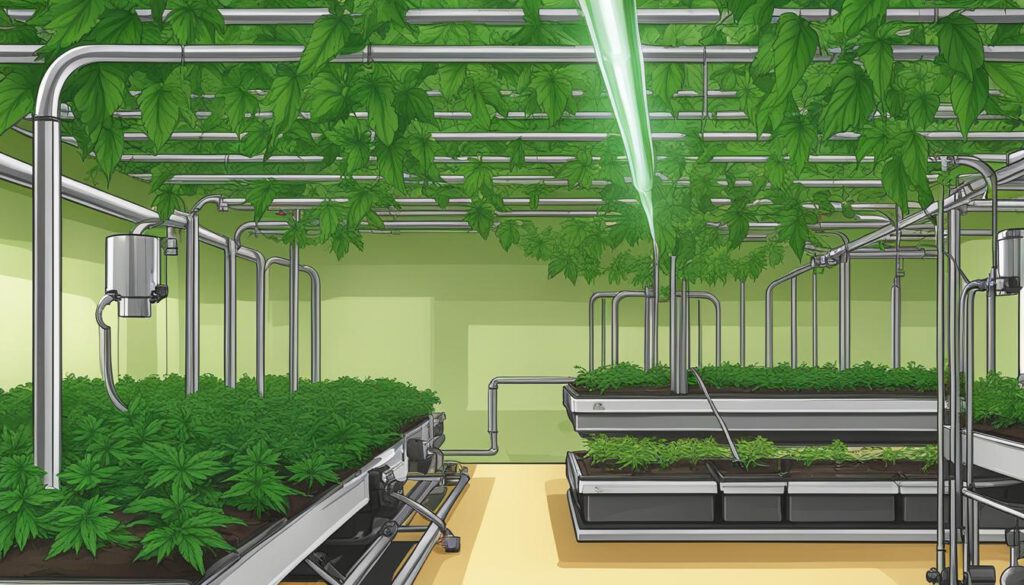
It’s essential to choose a hydroponics system that fits your space, budget, and growing needs. Whichever system you choose, make sure to monitor the pH levels and nutrient concentrations regularly to avoid nutrient imbalances and plant stress.
Benefits of Hydroponics Systems
Hydroponics systems offer several benefits for indoor cannabis growers. First, hydroponics eliminates the need for soil, which can carry pests and diseases. Additionally, hydroponics systems deliver nutrients directly to the roots, promoting faster and healthier plant growth.
Secondly, hydroponics systems use less water than traditional soil methods, making them more environmentally friendly and cost-effective. Finally, since hydroponics systems provide precise control over nutrient delivery, growers can achieve consistent yields and potency levels.
When combined with other essential equipment like grow lights, ventilation systems, and pruning tools, hydroponics systems can help you create a highly efficient and productive indoor cannabis garden.
Grow Lights for Indoor Cannabis Cultivation
When it comes to indoor cannabis cultivation, providing adequate lighting is crucial for healthy plant growth and maximum yields. Choosing the right grow lights requires careful consideration of factors such as light intensity, spectrum, and energy efficiency.
LED grow lights are a popular choice for indoor cannabis growers due to their energy efficiency and customizable spectrum options. They emit less heat than other types of grow lights, reducing the risk of heat damage to your plants.
High-Intensity Discharge (HID) lights are another option, providing high levels of light intensity and spectrum customization. However, they do emit more heat and use more energy than LED lights.
Fluorescent lights are a cost-effective choice for small-scale indoor cannabis growers. They are less powerful than LED and HID lights, but they emit less heat and are suitable for the vegetative stage of plant growth.
When selecting grow lights, be sure to consider the specific needs of your cannabis plants at each stage of growth. Seedlings and clones require lower light intensity than mature plants, and you may need to adjust the spectrum of your lights during the flowering stage.
Remember that providing too much or too little light can negatively impact your cannabis yield and quality. Use a light meter to measure light intensity and ensure your plants are receiving the optimal amount of light.
Comparing Grow Light Types
| Grow Light Type | Advantages | Drawbacks |
|---|---|---|
| LED | Energy efficient, customizable spectrum options, emit less heat | Higher upfront cost |
| HID | High light intensity, customizable spectrum options | Emit more heat, use more energy |
| Fluorescent | Cost-effective, emit less heat, suitable for vegetative stage | Less powerful than LED and HID lights |
By selecting the appropriate grow lights for your indoor cannabis garden, you can create an optimal environment for healthy plant growth and maximum yields.
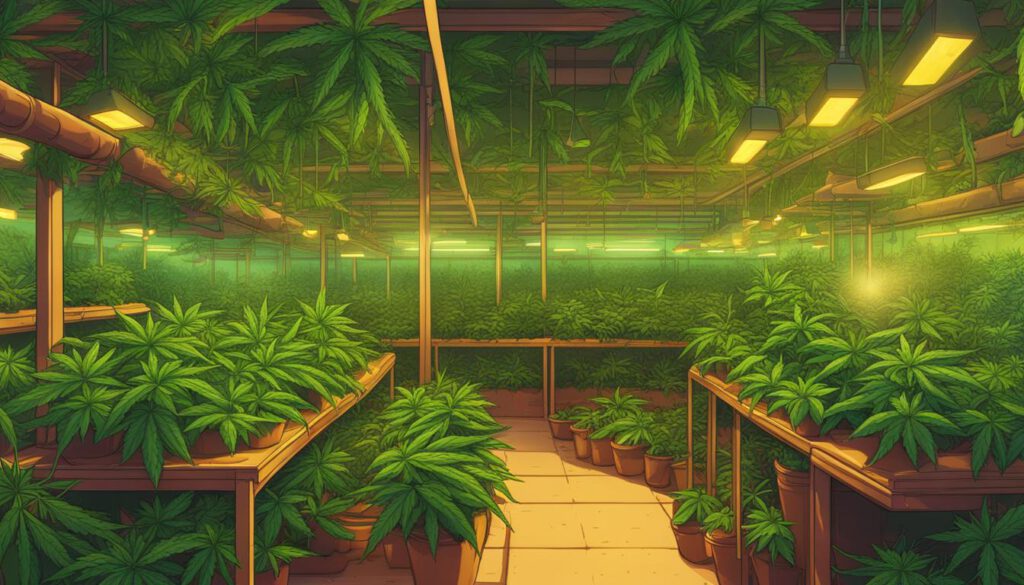
Ventilation Systems and Carbon Filters
Adequate ventilation is essential for healthy growth of cannabis plants, especially in an indoor environment. Ventilation systems help to control air circulation, temperature, and humidity levels in the grow room.
The air in your grow room needs to be exchanged regularly to ensure enough fresh carbon dioxide (CO2) for photosynthesis and prevent the buildup of heat and humidity. A good ventilation system also helps to prevent the growth of harmful molds and fungi that can damage your plants.
Ventilation Systems
There are a few different types of ventilation systems available for indoor cannabis growing, including exhaust fans, intake fans, and oscillating fans. The type of ventilation system you choose will depend on the size of your grow room, the number of plants you are growing, and other environmental factors.
Exhaust fans provide a constant flow of fresh air into the grow room while simultaneously removing stale, humid air outside. This helps to maintain the temperature and humidity levels in the grow room.
Intake fans, on the other hand, pull fresh air from the outside into the grow room to replace the stale air. These fans are useful in small grow spaces as they help to regulate temperature and humidity levels.
Oscillating fans are also essential for indoor cannabis growing as they help to circulate the air and prevent hot spots from forming. They also help to strengthen the stems of your plants and prevent them from growing too tall or spindly.
When selecting a ventilation system, choose one that is powerful enough to handle the size of your grow room. A general rule of thumb is to have an exhaust fan that can exchange the air in the grow room every 1 to 3 minutes.
Carbon Filters
Carbon filters are an essential component of any indoor cannabis grow room. They help to control the odor that is naturally produced during the growing process.
A carbon filter works by removing the odor molecules from the air as it is circulated through the filter. This results in fresher, cleaner air being released back into the grow room. Without a carbon filter, the odor produced by your cannabis plants can be overwhelming and easily detectable.
Carbon filters are typically installed in-line with your ventilation system, either at the intake or exhaust end. They require periodic replacement to ensure that the filter continues to work effectively.
In summary, ventilation systems and carbon filters are essential equipment for indoor cannabis growing. A good ventilation system helps to regulate air circulation, temperature, and humidity levels in the grow room, while carbon filters help to control odor levels. By selecting the right equipment for your grow space, you can ensure healthy, robust plants and a successful harvest.
Nutrients and Fertilizers for Indoor Cannabis Plants
Indoor cannabis plants require specific nutrients and fertilizers to thrive and produce a bountiful harvest. Choosing the right nutrients and fertilizers for each growth stage can be challenging, but it’s essential to ensure your plants receive all the necessary elements for optimal growth.
The primary nutrients cannabis plants require are nitrogen (N), phosphorus (P), and potassium (K). These macronutrients are necessary for plant growth and can be found in most fertilizers. However, cannabis plants also need secondary and micronutrients, such as calcium (Ca), magnesium (Mg), and iron (Fe), to thrive.
Organic vs. Synthetic Nutrients
When selecting nutrients and fertilizers for your indoor cannabis plants, you’ll need to choose between organic and synthetic options. Organic nutrients are derived from natural sources and are often more sustainable and environmentally friendly. Synthetic nutrients are manufactured chemically and can provide faster results.
Organic nutrients can include composted soil, worm castings, guano, and other natural ingredients. Synthetic nutrients typically include N-P-K ratios and other essential elements in precise amounts. Depending on your grow setup and personal preferences, you may choose to use one or a combination of both organic and synthetic options.
Nutrient Supplements
In addition to primary, secondary, and micronutrients, cannabis plants may benefit from nutrient supplements. These supplements can include products like enzymes, beneficial bacteria, and mycorrhizae. They can improve nutrient uptake and support healthy root development.
Fertilizer Schedule
Creating a fertilizer schedule is critical to ensure your plants receive the proper nutrients throughout their growth cycle. A typical fertilizer schedule includes different formulations for the vegetative and flowering stages of growth. During each stage, there are different nutrient requirements, so it’s crucial to adjust the fertilizer schedule accordingly.
| Growth Stage | Primary Nutrients | Secondary Nutrients | Micronutrients |
|---|---|---|---|
| Vegetative | High N, Moderate P, Moderate K | High Ca, Moderate Mg | Fe, Mn, Zn, Cu, B |
| Flowering | Low N, High P, High K | High Ca, Moderate Mg | Fe, Mn, Zn, Cu, B |
It’s important to note that each strain of cannabis may have unique nutrient requirements. Conduct research on the specific strain you plan to grow to create the most effective fertilizer schedule.
Using the right nutrients and fertilizers can make a significant impact on the health and yield of your indoor cannabis plants. By following a proper fertilizer schedule and supplementing with necessary elements, you can support robust growth and produce exceptional cannabis at home.
pH Meters, Humidity Control, Pruning, and Trimming Tools
Maintaining the proper pH level and humidity in your indoor cannabis garden is essential for healthy plant growth. By investing in pH meters and humidity control equipment, you can ensure that you are providing the optimal conditions for your cannabis plants.
A pH meter measures the acidity or alkalinity of your nutrient solution. This information is crucial as cannabis plants require different pH levels during different growth stages. For example, during the vegetative stage, the pH level should be between 5.5 and 6.5, while during the flowering stage, it should be between 6.0 and 7.0. Failure to maintain the correct pH level can result in nutrient deficiencies and stunted growth.
Humidity control equipment such as dehumidifiers and humidifiers can help you maintain the proper humidity levels. During the vegetative stage, the humidity should be between 50% and 70%, while during the flowering stage, it should be between 40% and 50%. Proper humidity control can prevent mold and mildew growth and reduce the risk of pests.
Pruning and Trimming Tools
Pruning and trimming are crucial for shaping and maintaining healthy cannabis plants and maximizing bud production. Pruning involves removing unwanted leaves and branches, while trimming involves removing excess foliage from buds.
Some essential pruning and trimming tools for indoor cannabis growing include:
- Pruning shears
- Trimming scissors
- Bud trimmers
- Leaf trimmers
Investing in high-quality pruning and trimming tools can make the process easier and more efficient, resulting in healthier plants and increased yields.
With the right equipment and knowledge, you can maintain optimal pH levels and humidity control and keep your cannabis plants healthy throughout the growing cycle. Stay tuned for the next section where we will discuss pest control and water filtration systems, essential for successful indoor cannabis growing.
Pest Control and Water Filtration Systems
When growing cannabis indoors, pest control is a critical aspect of maintaining plant health and yield. Pests such as spider mites, thrips, and whiteflies can quickly damage your plants, so it’s important to have effective pest control products on hand.
One option is to use natural predators to control pests, such as ladybugs or predatory mites. Alternatively, you can use organic or synthetic pesticides to manage pest populations. Whatever your choice, be sure to follow instructions carefully and only use products that are safe for cannabis plants.
Water quality is another key consideration when growing cannabis. Using unfiltered tap water can expose your plants to harmful chemicals and minerals, affecting growth and yield. Consider investing in a water filtration system to remove impurities and ensure clean, consistent water for your plants.
Water Filtration Systems
There are several types of water filtration systems available for indoor cannabis cultivation. Reverse osmosis (RO) systems are popular for removing a wide range of impurities, including chlorine, heavy metals, and pesticides. However, they can also remove beneficial minerals that help promote plant growth. Activated carbon filters are another option, effectively removing chlorine and other chemicals while leaving minerals intact.
When choosing a water filtration system, consider the size of your grow operation and your budget. Some systems can be expensive and require regular maintenance, while others are more affordable and low-maintenance. Remember that water quality is a critical factor in cannabis growth, so investing in a reliable filtration system is worthwhile.
By implementing effective pest control measures and investing in a reliable water filtration system, you can ensure the health and vitality of your indoor cannabis plants. With all the essential equipment in place, you can create the optimal growing environment and maximize your cannabis yield.
Conclusion
Equipping yourself with the essential equipment for indoor cannabis growing is crucial to achieving a successful harvest. By carefully considering each component and adapting to the specific needs of your plants, you can create the ideal environment for healthy growth and maximize your yields.
Remember to stay informed about the latest advancements in indoor cultivation, as new technologies and techniques are constantly emerging. With the right equipment and knowledge, you can achieve remarkable results in your indoor cannabis garden.
It’s important to note that achieving optimal results does not happen overnight and requires patience, dedication, and attention to detail. But with the right equipment and a little bit of know-how, you can turn your indoor cannabis cultivation into a rewarding and fruitful experience.
FAQ
What essential equipment do I need for indoor cannabis growing?
The essential equipment for indoor cannabis growing includes hydroponics systems, grow lights, ventilation systems, carbon filters, nutrients and fertilizers, pH meters, humidity control equipment, pruning and trimming tools, pest control products, and water filtration systems.
What are hydroponics systems and why are they important?
Hydroponics systems are soilless growing methods that allow for precise control over nutrient delivery. They are important for indoor cannabis cultivation as they provide optimal conditions for plant growth and can result in higher yields.
What types of grow lights are suitable for indoor cannabis cultivation?
Different types of grow lights, such as LED, HID, and fluorescent lights, are suitable for indoor cannabis cultivation. Each type has its advantages and drawbacks, and the right intensity and spectrum should be chosen for each stage of plant growth.
Why is ventilation important for indoor cannabis growing?
Proper air circulation is crucial for healthy cannabis growth as it helps prevent mold, mildew, and other plant diseases. Ventilation systems, including exhaust fans, intake fans, and carbon filters, are used to maintain optimal airflow and control odors in the grow space.
What nutrients and fertilizers are necessary for indoor cannabis plants?
Indoor cannabis plants require a balanced supply of nutrients for vigorous growth and abundant yields. Different types of nutrients and fertilizers, including organic and synthetic options, can be used. It is important to provide the essential nutrients needed for each growth stage.
Why is maintaining the correct pH level and humidity important for indoor cannabis cultivation?
Maintaining the correct pH level and humidity is crucial for optimal cannabis growth. pH meters and humidity control equipment are used to monitor and adjust these factors to create an ideal environment for the plants.
How can I protect my indoor cannabis garden from pests?
Protecting your indoor cannabis garden from pests is essential for a successful harvest. There are different pest control products and methods available to prevent and manage common cannabis pests. Regular monitoring and proper sanitation practices are also important.
What is the importance of water filtration systems for indoor cannabis growing?
Water filtration systems are used to ensure the quality and purity of water for cannabis plants. Removing impurities and maintaining appropriate water pH can help prevent nutrient deficiencies and plant health issues.
How can I maximize my yields in indoor cannabis growing?
By equipping yourself with the essential equipment for indoor cannabis growing and creating an ideal environment for healthy plant growth, you can maximize your yields. It is important to carefully consider each component, adapt to the specific needs of your plants, and stay informed about the latest advancements in indoor cultivation.


